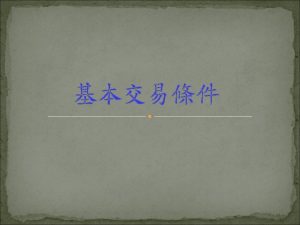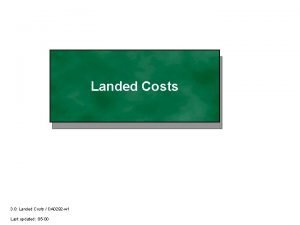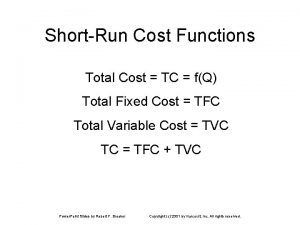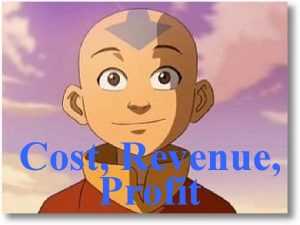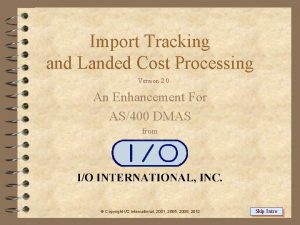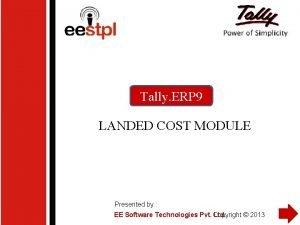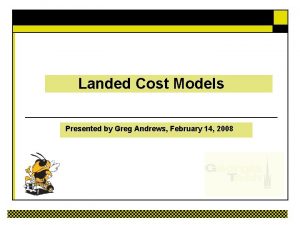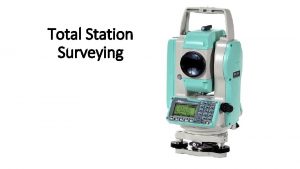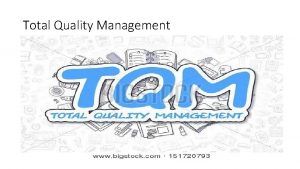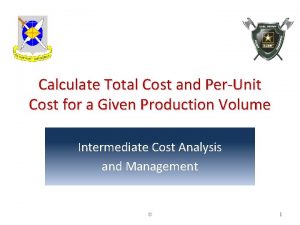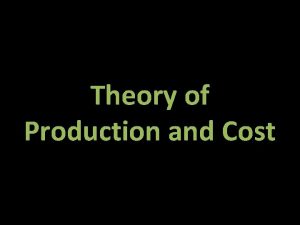Development of a Total Landed Cost and Risk























- Slides: 23

Development of a Total Landed Cost and Risk Model for Strategic Sourcing LGO/SDM Web Seminar Series Brian Feller n July 18, 2008 Presentation title

Presentation Purpose 1. Provide a brief overview of Perkin. Elmer, Inc. 2. Review the project objectives 3. Describe the cost model functionality 4. Describe the risk model functionality 5. Present a case study where the model was used 6. Discuss overall model benefits and opportunities Presentation title 2

About Perkin. Elmer A global technology leader driving growth and innovation in Health Sciences and Photonics markets to improve the quality of life. • Project focus is on the Analytical Sciences business • Primary products manufactured are diagnostic instruments used in a variety of industries including biopharma, consumer products, academia, and environmental services • Manufacturing operations in Shelton, CT, Llantrisant, Wales, and Singapore • Manufacturing is high mix and low volume • Majority of existing supply base is regionally located to the manufacturing sites Genetic Screening Environmental Biopharma Health Sciences Detection and Analysis 63% Diagnostics 20% 63% Detection and Analysis Diagnostics 20% Medical Imaging Photonics Service 17% Specialty Lighting Optical Sensors Presentation title 3

Project Objectives • Facilitate global sourcing decisions by including major costs associated with a supplier selection • Create a common supplier evaluation tool for all global manufacturing sites • Standardize the supplier selection process • Promote supply chain risk to be considered in sourcing decisions • Leverage spend with suppliers that are capable of developing long-term partnerships with Perkin. Elmer • Engage suppliers in low cost countries after balancing landed cost, supply chain risk, and material complexity • Raise awareness of impact on sourcing decisions related to all other cost factors beyond material cost (e. g. trade compliance, finance, inventory, etc. ) • Provide a learning opportunity for the entire project team Presentation title 4

Cost Model Overview Summary of costs included in the model: LOGISTICS • Freight (air, ground, and ocean) • Fuel surcharges • Accessorial charges TRADE COMPLIANCE • Duty • Tariffs • Custom clearance fees INVENTORY • Safety stock cost • Inventory carrying cost • Pipeline inventory cost • Warehousing fees PURCHASING • Material cost • Packaging cost • One-time charges • Supplier qualification charges FINANCE • Tooling and fixture cost • Payment term differences • Discount valuation Key factors in determining freight: • • • Order quantity/demand Package weight Shipping carton dimensions Order frequency Transportation mode Supplier origin Key Cost Model Assumptions: • • “ 95%” of costs are included Designed as a sourcing decision making tool, NOT a freight cost calculator Included costs Presentation title 5

Total Landed Cost Model Features • Allows for three suppliers to be reviewed at one time • Allows for up to three different transportation modes per supplier • Allows for up to three different packaging configurations per supplier to compare freight savings opportunities • Requests the user to input the order frequency, which can have as many as three different values, to compare freight cost vs. inventory holding cost • Develops cost based on inputs that can be unique for each supplier (e. g. service level, freight terms, payment terms, etc. ) • Determines the value of discounts vs. contracted payment terms • Includes a template to compare quote packages for the optimal award mix • Allows for “what-if” scenarios to be analyzed to compare trade-offs for freight, inventory, material cost, payment terms, etc. History and Archives Confidential • Includes full reporting capability for all scenarios • Maintains quote history for future comparison and sourcing decisions • Allows the reuse of existing data to expedite supplier profile data entry • Allows for future analysis of past sourcing decisions Presentation title 6

Cost Model Overview – Freight Cost Methodology Using the supplier and shipment characteristics listed below, the estimated landed cost is calculated for each supplier and scenario utilized. The model was created using a cost matrix design shown below. Unlimited >2 Options 3 Options 207 Options SUPPLIER 1 Scenario 2 Scenario 3 SUPPLIER 2 Scenario 1 Scenario 2 Scenario 3 SUPPLIER 3 Scenario 1 Lead Time Packaging Order Frequency Carrier Service Type Scenario 2 Scenario 3 Freight Mode Manufacturing Origin/Country Presentation title 7

Cost Analysis Functionality and Opportunities • Use the model for simple OR complex supplier comparisons • Consider cost differences between freight modes • Compare varying part costs for one supplier • Encourage suppliers to provide detailed quotes so specific cost components can be analyzed • Compare freight services (e. g. priority, economy, etc. ) for cost savings opportunities • Partner with suppliers to understand shipping carton capacity • Understand how forward stocking locations may reduce freight cost • Use the model for an incumbent supplier to do what-if analysis: • Order less often • Use ocean freight • Utilize multi-mode shipping Demand Profile units Variable Demand Air Freight Opportunity Predictable Demand Ocean Freight Opportunity Ground Freight Opportunity months Presentation title 8

Cost Analysis Opportunities • Consider total cost savings opportunities, not just material cost variance • Understand cost inflection point for low cost country or domestic sourcing Supplier 1 Supplier 2 Landed Cost Supplier 1 Freight Cost Supplier 2 Supplier 1 Quantity Material Cost • Include all relevant costs that may impact the sourcing decision (e. g. tooling, payment terms, warehouse fees, qualification expenses, etc. ) • Engage other areas of expertise for sourcing decisions (e. g. Logistics, Trade Compliance, Inventory, Quality, etc. ) and supply chain strategy Presentation title 9

Cost Model GUI Presentation title 10

Risk Model Overview Primary Risk Model Attributes • Creates a risk portfolio following FMEA results • Normalizes risk scaling (0. . 100) • Minimizes subjectivity • Standardizes analysis methodology • Generates a risk adjusted cost Risk Portfolio Presentation title 11

Risk Analysis – Risk Portfolio Statistics from FMEA Presentation title 12

Risk Index - A utility-weight risk index calculation process Supplier A 25 PTS 1 DAY 5 DAYS 10 DAYS 15 YEARS 10 YEARS 62 13 DAYS 75 PTS 100 PTS 15 DAYS 20+ DAYS 75 PTS 5 YEARS 100 PTS 80 <=1 YEAR 4 YRS 100 PTS 50 PTS 75 PTS 17 YRS 7 DAYS 25 PTS 75 PTS >20 YEARS 50 PTS 37 25 PTS 20 0 PTS 25 PTS Experience Weight = 4. 1% 0 PTS 50 PTS Lead Time Weight = 5. 6% Supplier B 65 Capacity Util. Weight = 5. 9% Risk 18 30% 45% 60% 75% 80% 90% 88% 64% 100% Cost Supplier A Risk Index = E(A) = (37 * 0. 056) + (80 * 0. 041) + (18 * 0. 059) = 6. 41 Supplier B Risk Index = E(B) = (62 * 0. 056) + (20 * 0. 041) + (65 * 0. 059) = 8. 13 Presentation title 13

Risk Adjusted Cost Methodology For example, after all 19 risk factors have be evaluated… Supplier A Risk Index = E(A) = 36. 3 Supplier B Risk Index = E(B) = 50. 1 … Risk Index 100 50. 1 ∆ = 13. 8 36. 3 ∆ = 35. 1 rf = 15. 00 ∆ = 21. 3 0 $800, 000 Total Landed Cost $915, 500 ∆ = $115, 000 Does lower risk justify higher cost? Presentation title 14

Risk Adjusted Cost Calculation Risk-Adjusted Cost Calculations Risk Category Computed Risk Index Logistics/Trade Compliance 11. 3 Inventory/Quality 9. 1 Purchasing/Organization 12. 7 Finance/R&D 3. 2 Total Risk Index Cost Category Adjustment factor = 11. 3% Adjustment factor = 9. 1% Adjustment factor = 12. 7% Adjustment factor = 3. 2% 36. 3 Landed Cost (USD) Freight Inventory Carrying Cost Packaging Warehousing $200, 000 $18, 000 $5, 000 $33, 000 * 1. 091 = $36, 000 $10, 000 Material $650, 000 Tooling $30, 000 Finance $2, 500 Total Landed Cost $200, 000 * 1. 113 = $222, 600 $680, 000 * 1. 127 = $766, 360 $2, 500 * 1. 032 = $2, 600 $915, 500 Total Risk-Adjusted Cost = $1, 027, 560 Cost associated with supplier risk = $1, 027, 560 - $915, 500 = $112, 060 Presentation title 15

Risk Adjusted Cost and an Efficient Frontier • An investment portfolio can be created for any point in green • Any point on the curve represents the optimal return for a specified risk (or vice-versa) • Portfolios do NOT exist for the risk-return points outside the space or the curve • Portfolios on the frontier are generally diverse • Over time, gather data on the following: * Graphic from riskglossary. com Relative to Supplier Risk… • Supplier risk index results • Part type Risk Index • Cost (cost/unit) Cost • Use the data to plot an efficient frontier for supplier/part type relationships to help assess potential new suppliers • Consider selecting suppliers that are on or close to the curve to minimize the cost/risk tradeoff Presentation title 16

Risk Analysis Functionality and Opportunities • Consider the risk adjusted cost along with the estimated landed cost • Analyze and compare the total risk indices of each supplier • Many low level risk factors vs. few high level risk factors • Balanced risk portfolio • Acceptable risk levels based on part(s) being sourced • Understand risk by operational category (logistics, purchasing, etc. ) • Develop mitigation plans for the highest risk factors • Partner with suppliers to help them improve in those areas that PKI considers high risk • Utilize the risk analysis process with initial supplier qualifications and periodic reviews • Incorporate risk indices when determining a sourcing strategy (see next slide) Presentation title 17

Risk Analysis Opportunities Single Sourcing Dual Sourcing Risk 2 1 Cost Multi Sourcing Example 2 3 3 Risk 1 -A Cost 2 -A 1 -B 1 2 -B Cost 1 Sourcing decision 1 2 Sourcing decision 2 Presentation title 18

Risk Model GUI Presentation title 19

Case Study – Risk Analysis Dashboard 1 3 2 4 Presentation title 20

Case Study – Landed Cost Model Output Presentation title 21

Overall Model Benefits and Functionality • • • Provides a holistic view of sourcing costs and risks Calculates a risk-adjusted cost using the supplier risk indices Standardizes the cost and risk analysis process within the business around one tool Presents support for sourcing decisions in low cost countries, domestically, or otherwise Contributes to other business factors used in the decision making process • Consolidation of spend • Cost reductions for volume increases Utilizes current and real-time data sources to ensure model accuracy Archives quote and risk information for future use and reference • • Landed cost estimates Risk indices • Sourcing alternatives by supplier and selection documentation Includes operational differences for global sites Supports expansion and portability for other Perkin. Elmer businesses to adopt Presentation title 22

Questions and Discussion Contact information: bfeller@sloan. mit. edu Presentation title
 Oracle landed cost management
Oracle landed cost management Shipped quality terms
Shipped quality terms Market risk credit risk operational risk
Market risk credit risk operational risk Formula de roe
Formula de roe Total revenues minus total costs equals
Total revenues minus total costs equals Total revenues minus total costs equals
Total revenues minus total costs equals Total revenues minus total costs equals
Total revenues minus total costs equals Total revenue minus total expenses
Total revenue minus total expenses Residual risk and secondary risk pmp
Residual risk and secondary risk pmp Business risk vs financial risk capital structure
Business risk vs financial risk capital structure Relative risk and attributable risk
Relative risk and attributable risk Parirt
Parirt Cost accumulation and cost assignment
Cost accumulation and cost assignment Cost accumulation and cost assignment
Cost accumulation and cost assignment Cost accumulation and cost assignment
Cost accumulation and cost assignment What is a period cost on the income statement
What is a period cost on the income statement Dennis geyer
Dennis geyer Meaning of
Meaning of Distinguish between average cost and marginal cost
Distinguish between average cost and marginal cost Cost control and cost reduction difference
Cost control and cost reduction difference Job order costing vs process costing
Job order costing vs process costing Ordering cost and carrying cost
Ordering cost and carrying cost Opportunity costs and trade offs
Opportunity costs and trade offs Cost control and cost reduction project report
Cost control and cost reduction project report

